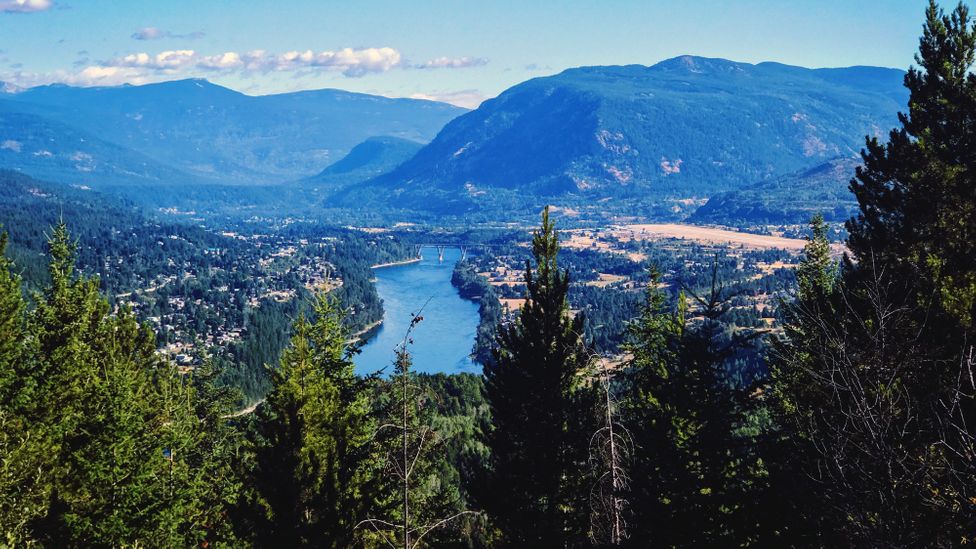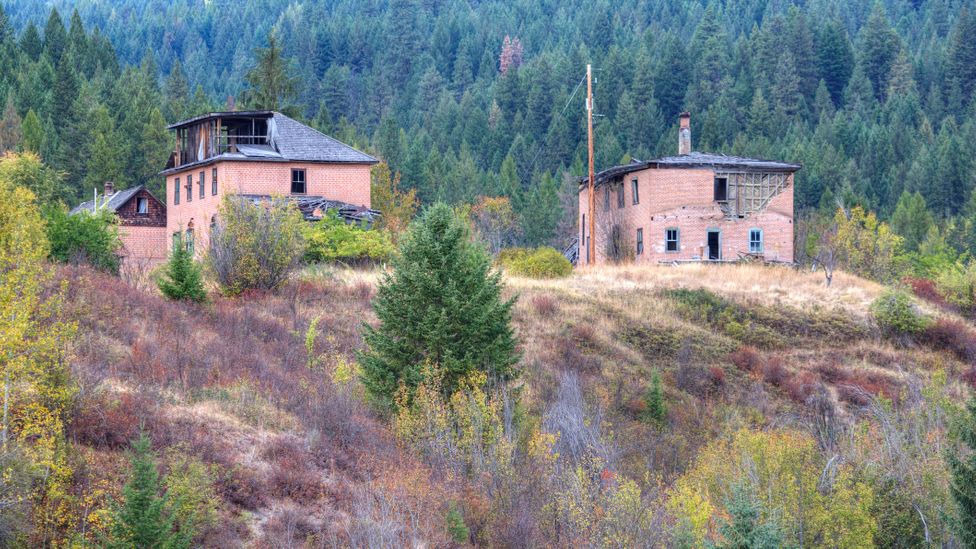High on a bluff above Western Canada's Columbia River, just outside the small town of Castlegar, beautiful harmonies filled the air. I was sitting in the garden of the Doukhobor Discovery Centre beneath a statue of the great Russian novelist Leo Tolstoy, listening to a recording of an a cappella Doukhobor choir singing a haunting psalm. It sounded like a multi-tracked version of Crosby, Stills & Nash rendered in Russian.
"When the Doukhobors sing, it's a powerful occasion," explained Ryan Dutchak, the centre's director of museum and culture and an active choir member. "It gives you the chills. It's like you're taking part in history, making a strong connection with your ancestors in both Russia and Canada."
While most people visit British Columbia's mountainous West Kootenay region to indulge in intrepid outdoor pursuits, I had arrived to ponder Tolstoy and penetrate the idiosyncratic and little-explored world of the Doukhobors.
The Doukhobors are a small ethno-religious group of Russian origin that broke away from the Eastern Orthodox Church in the early 1700s. Persecuted as "heretics" for more than two centuries by successive Russian emperors and empresses, they migrated en masse to Canada in 1899. As conscientious devotees of non-violence and egalitarianism, the group were natural bedfellows for the ascetically minded Tolstoy. Sympathetic to their pacificism and communal non-materialistic lifestyle, the influential writer played a pivotal role in their emigration, even donating royalties from his novel Resurrection to help fund their journey.

While many Doukhobors settled in western Canada, small communities remain in the Caucuses, such as in Azerbaijan (Credit: Asif Masimov/Alamy)
Located seven driving hours east of Vancouver, the Doukhobor Discovery Centre occupies a handsome ensemble of red-bricked buildings flanked by well-tended fields and gnarly apple trees. A white dove emblazoned on the side of a barn ushered me in, and a sign reading "Toil and Peaceful Life" over the entrance porch suggested an atmosphere of quiet industry inside. Wrapped around a grassy courtyard, several rooms of carefully curated exhibits depicted the Doukhobor's long journey from Russia to Canada and the tight-knit communal style of living that was once their hallmark.
Known today in Canada for their pacifism, vegetarianism and dulcet Russian-language choirs, the Doukhobors evade neat classification. Some historians point to their similarities with the Quakers and the Mennonites. Others refer to them as proto hippies. Possessors of a strong work ethic, they have long been admired for their carpentry and agricultural skills. When the Canadian government was looking for pioneering farmers to settle its rugged interior in the 1890s, there were no better candidates.
You may also be interested in:
• Canada's forgotten Hawaiian islands
• Europe's language that few speak
• The Swiss village lost in Canada
"The most central Doukhobor belief is that the spirit of God dwells within each living being," Dutchak said. "This tenet lends itself to a number of Doukhobor religious beliefs, including a rejection of religious icons, an emphasis on equality and collectivity as well as non-violence and pacifism.
Dutchak was bought up Catholic, but his grandmother hailed from a Doukhobor community in Saskatchewan. He was drawn to the religion after experiencing one of Castlegar's Peter's Day festivals, a celebration of prayer, singing and Russian cooking held every June. "I was attracted to their ideas about equality and pacifism," he told me. "In the 1960s, the Doukhobors helped organise peace vigils in Canada and they continue to assert their identity through pacificism today."
Dutchak went on to learn Russian and write a master's thesis on Doukhobor culture. He started singing in a choir and reconnected with his Doukhobor roots. "For me, the Doukhobors remain highly relevant," he said. "They have a lot to offer contemporary society."
Between 1899 and 1938, the Doukhobors thrived in dozens of independent agrarian villages in Canada. The Discovery Centre is essentially a reconstruction of one of their unique self-sufficient communities. Inside, I examined a suite of austere dorms, barns full of old farming implements, a wood-fired oven for making bread and several Rumpelstiltskin-like spinning wheels that were used to make the distinctive tunics and shawls that Doukhobors still wear on special occasions.

The mountainous West Kootenay region is home to many of British Columbia's Doukhobors (Credit: Kari Bartel/Getty Images)
On our way around the gathered exhibits, Dutchak pointed out a table containing the "life elements" of salt, bread and water, the only embellishments allowed at Doukhobor moleniyas (prayer meetings), which take place in plain, simple rooms rather than ornate churches. "The Bible is considered more of a historical text than a holy book," he said. Rather than recite it, the group sing psalms.
The Doukhobor's roots can be traced to the early 18th Century in Imperial Russia. A dissenting Christian sect that rejected the liturgy of the Orthodox church, they gained a reputation as "troublemakers" whose egalitarian views were at odds with Russia's repressive serf society. It was in the late 18th Century that an Orthodox archbishop first began referring to them as "Doukhobors" or "Spirit Wrestlers". He devised the term as a put-down – they were wrestling against the spirit – but over time the Doukhobors embraced the name and redefined its meaning: they were wrestling with the spirit to find the truth.
In the 19th Century, the group was exiled first to the Black Sea and then to the Caucasus region on the periphery of the sprawling Russian Empire, where they lived independently in small villages embracing the "toil and peaceful life" motto that came to define them.
Change came in the 1890s when the emergence of a charismatic new Doukhobor leader, Peter "Lordly" Verigin, coincided with the ascension of Nicholas II to Russia's imperial throne. Nicholas insisted on an oath of allegiance from groups across the Empire. Ever distasteful of state interference, the Doukhobors refused, and, in 1895, on the instructions of Verigin (who had been exiled to Siberia in 1887), they destroyed all their weapons in protest in a sacrificial "burning of arms".
As the hostility of the Russian government intensified, Tolstoy and the British Quakers intervened to aid the Doukhobor emigration to Canada. Around 7,500 of the group arrived on four ships in early 1899 agreeing to settle and farm undeveloped territory in the interior on two conditions: that they would be exempted from military service; and they would be permitted to own their land communally. Initially they decamped to the prairies of Saskatchewan, where Verigin joined them in 1902, but, after the provincial government reneged on its promise to allow collective land ownership in 1908, Verigin led most of the group west to British Columbia in one of the largest organised internal migrations in Canadian history. Here, they laid roots in a small community christened Brilliant adjoining the nascent town of Castlegar.

The Doukhobors were known for their strong work ethic and communal non-materialistic lifestyle (Credit: Brendan Sainsbury)
I had visited Brilliant the previous day to see the tomb of Peter Verigin and admire the Brilliant Suspension Bridge, built by the Doukhobors in 1913 to link communities on either side of the Kootenay River. Pastoral and diminutive, the village and its surrounding area once supported a commune of around 6,000 Doukhobors centred on a grain elevator and a jam factory. The factory is long gone, but the bridge has been reincarnated as a national historic site. On a large interpretive signboard, I read how it was constructed in five months by 100 Doukhobor volunteers using reinforced concrete and bundled wire cables.
While only a handful of Doukhobors remain in Brilliant today, the village retains a cultural centre run by the Union of Spiritual Communities of Christ (USCC), a charitable society that keeps Doukhobor heritage alive through arts, crafts and humanitarian initiatives. The centre acts as a community hub, hosting not just prayer meetings, but banquets, choir performances, weddings and funerals.
"Members participate in regular prayer services on Sundays, while cooking groups make bread, lapsha (noodles) and borshch," explained Vera Kanigan, who I met in the Discovery Centre's sunny courtyard under Tolstoy's watchful gaze. She explained that she is a longstanding member of Castlegar's Doukhobor community and speaks Russian.
"There are several organised choirs as well as groups that organise and participate in promoting peace, environmental and social justice activities," she added. "A men's group gathers to make caskets and other wood crafts, and the cultural centre offers a pre-school programme in the Russian language."
Verigin's tomb occupies a manicured flower garden on a rocky promontory directly above the bridge. The spiritual leader was killed in a 1924 train explosion that bore all the hallmarks of a targeted assassination. Mysteriously, the case remains unsolved.

The Doukhobor Discovery Centre in Castlegar brings the community together through food, religious meetings and group singing (Credit: Brendan Sainsbury)
By the 1920s, debates over land ownership and cultural assimilation had led to fissures in Canada's Doukhobor movement. A small splinter group called the Sons of Freedom broke away and embarked on a series of radical protests that included arson attacks and nude parades. Regaling against encroaching materialism and the absorption of their children into the Canadian educational system, their actions attracted notoriety and negative attention in the press. It also landed many of the Sons of Freedom in jail and prickled the wider law-abiding Doukhobors who were often wrongly mistaken for them.
The final straw came in 1938 when the Great Depression, coupled with poor financial management, led to the foreclosure of all Doukhobor properties. Their collectively owned land, purchased by Peter Verigin in 1908, was promptly requisitioned by the Canadian government. Doukhobor villages were gradually disbanded and their inhabitants assimilated into Canadian culture.
There are said to be between 20,000 and 30,000 Doukhobors in Canada today, although only around one-tenth follow the spiritual practices. "Aside from Castlegar, communities can be found in Grand Forks, British Columbia, and Calgary, Alberta," Dutchak told me. "There are also Doukhobor communities in Saskatoon and Verigin in Saskatchewan where there's another heritage village."
While communal living is a thing of the past, there are encouraging signs to suggest that the culture will survive – and not just in the archives of a museum. Through festivals, food, religious meetings and group singing, Castlegar's Doukhobor Discovery Centre enthusiastically pushes interactive pursuits.
"We employ between two to six students as summer guides, and borshch, pyrohi (potato dumplings) and lapsha made by members of the community is served at our onsite bistro, which will hopefully be able to open again later this summer," said Dutchak. "In 2019, we even hosted a borshch cook-off where participants brought their homemade borshch to share with visitors and judges."
As I left, I stole a last glance at Tolstoy standing nobly on his plinth, the choir music still lilting gently in the background. I'm sure he would have approved.

The Doukhobors once thrived in dozens of agrarian villages in Canada, some of which now lie in ruins (Credit: GeoStock/Getty Images)
Our Unique World is a BBC Travel series that celebrates what makes us different and distinctive by exploring offbeat subcultures and obscure communities around the globe.
Join more than three million BBC Travel fans by liking us on Facebook, or follow us on Twitter and Instagram.
If you liked this story, sign up for the weekly bbc.com features newsletter called "The Essential List". A handpicked selection of stories from BBC Future, Culture, Worklife and Travel, delivered to your inbox every Friday.
June 24, 2021 at 06:44AM
https://www.bbc.com/travel/article/20210623-canadas-little-known-russian-sect
Canada's little-known Russian sect - BBC News
https://news.google.com/search?q=little&hl=en-US&gl=US&ceid=US:en

No comments:
Post a Comment